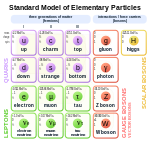Laboratori Nazionali del Gran Sasso
 Overview of overground laboratories of LNGS | |
| Established | 1985 |
|---|---|
| Research type | Particle physics, nuclear physics |
| Director | Ezio Previtali (since October 2020) |
| Location | L'Aquila, Abruzzo, Italy 42°25′16″N 13°30′59″E / 42.42111°N 13.51639°E |
Operating agency | INFN |
| Website | www.lngs.infn.it |
| Beyond the Standard Model |
|---|
 |
| Standard Model |
Laboratori Nazionali del Gran Sasso (LNGS) is the largest underground research center in the world. Situated below
The primary mission of the laboratory is to host experiments that require a low background environment in the fields of astroparticle physics and nuclear astrophysics and other disciplines that can profit of its characteristics and of its infrastructures. The LNGS is, like the three other
Facilities
The laboratory consists of a surface facility, located within the
The first large experiments at LNGS ran in 1989; the facilities were later expanded, and it is now the largest underground laboratory in the world.[1]
There are three main barrel vaulted experimental halls, each approximately 20 m wide, 18 m tall, and 100 m long.[1] These provide roughly 3×20×100=6,000 m2 (65,000 sq ft) of floor space and 3×20×(8+10×π/4)×100=95,100 m3 (3,360,000 cu ft) of volume. Including smaller spaces and various connecting tunnels, the facility totals 17,800 m2 (192,000 sq ft) and 180,000 m3 (6,400,000 cu ft).[2][1]
The experimental halls are covered by about 1400 m of rock, protecting the experiments from
Research projects
Neutrino research
Since late August 2006,
In May 2010, Lucia Votano, Director of the Gran Sasso laboratories, announced, "The OPERA experiment has reached its first goal: the detection of a tau neutrino obtained from the transformation of a muon neutrino, which occurred during the journey from Geneva to the Gran Sasso Laboratory."[3] This was the first observed tau neutrino candidate event in a muon neutrino beam, providing further evidence that neutrinos have mass.[4] (Research first determined that neutrinos have mass in 1998 at the Super-Kamiokande neutrino detector.[5][6]) Neutrinos must have mass for this transformation to occur; this is a deviation from the classic Standard Model of particle physics, which assumed that neutrinos are massless.[6][7]
An effort to determine the
In September 2011, Dario Autiero, a researcher of Institute of Nuclear Physics in Lyons, France, presented preliminary findings that indicated neutrinos produced at CERN were arriving at OPERA detector about 60 ns earlier than they would if they were travelling at the speed of light. and therefore the case is completely solved, the development of the story has given the community pause for thought.
In 2014
Experiments
See also
References
- ^ a b c "INFN Laboratori Nazionali del Gran Sasso Annual Report 2011" (PDF). p. 4. Retrieved 16 August 2015.
- S2CID 5793486.
- ^ Particle Chameleon Caught in the act of Changing, Press Release, CERN, 31 May 2010, accessed 22 November 2016.
- ^
Agafonova, N.; Aleksandrov, Andrey; Altinok, Osman; Ambrosio, Michelangelo; Anokhina, Anna M.; Aoki, Shigeki; et al. (2010). "Observation of a first ντ candidate event in the OPERA experiment in the CNGS beam". Physics Letters B. 691 (3): 138–145. S2CID 119256958.
- ^ Schechter, Joseph; Valle, José W.F. (1980). "Neutrino masses in SU(2) ⊗ U(1) theories". Physical Review D. 22 (9): 2227–2235. .
- ^ a b New Experiment Aims to Crack Neutrino Mass Mystery, 4 November 2014, accessed 3 October 2021.
- ^ Cottingham, W.N.; Greenwood, D.A. (2007). An Introduction to the Standard Model of Particle Physics (2nd ed.). Cambridge University Press.
- .
- S2CID 12834643.
- .
- ^ Neutrinos sent from CERN to Gran Sasso respect the cosmic speed limit, 8 June 2012.
- ^
Adam, T.; et al. (S2CID 17652398.
- ^ First detection of solar neutrinos from the CNO cycle with Borexino, Indico-FNAL, , 23 June 2020.


